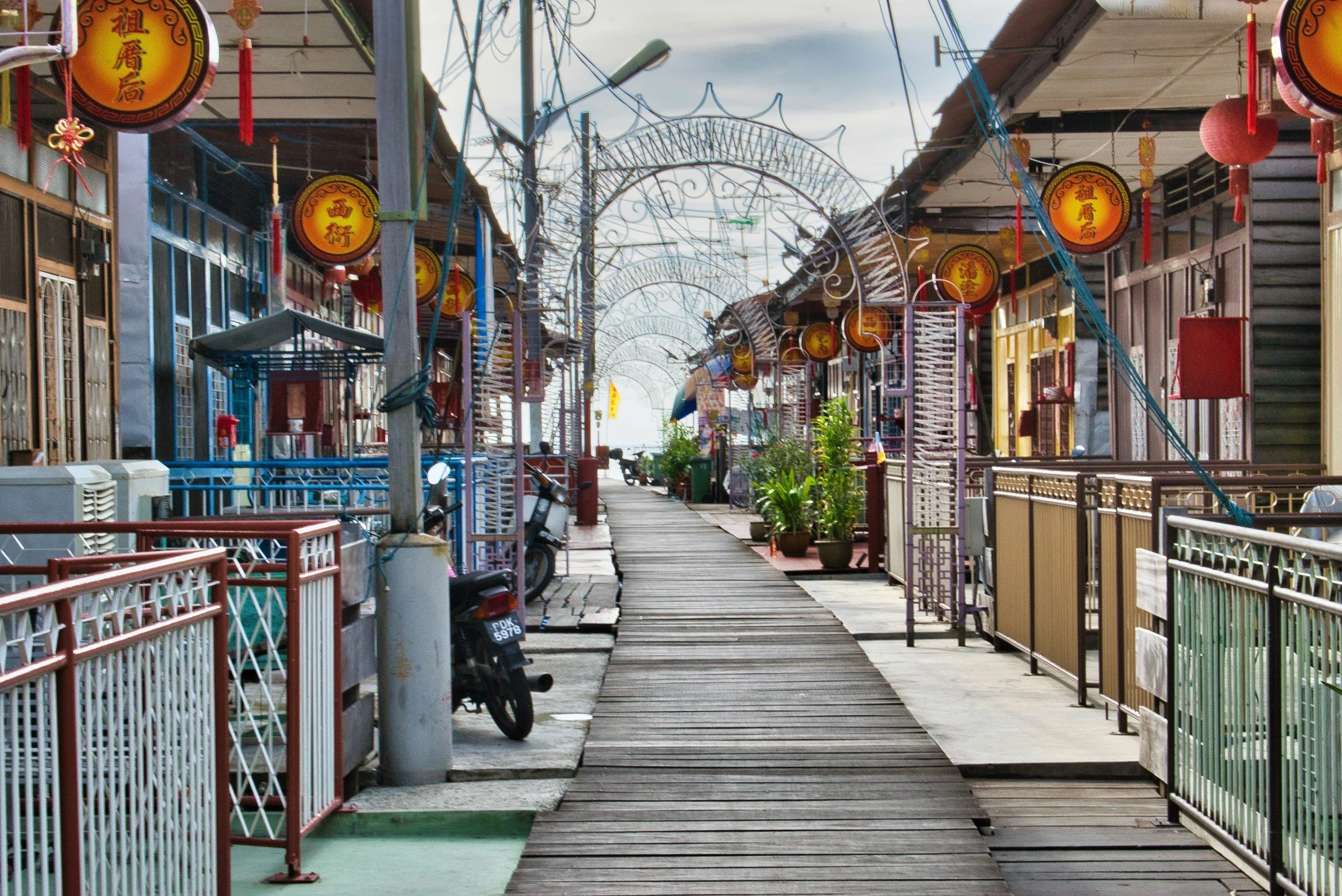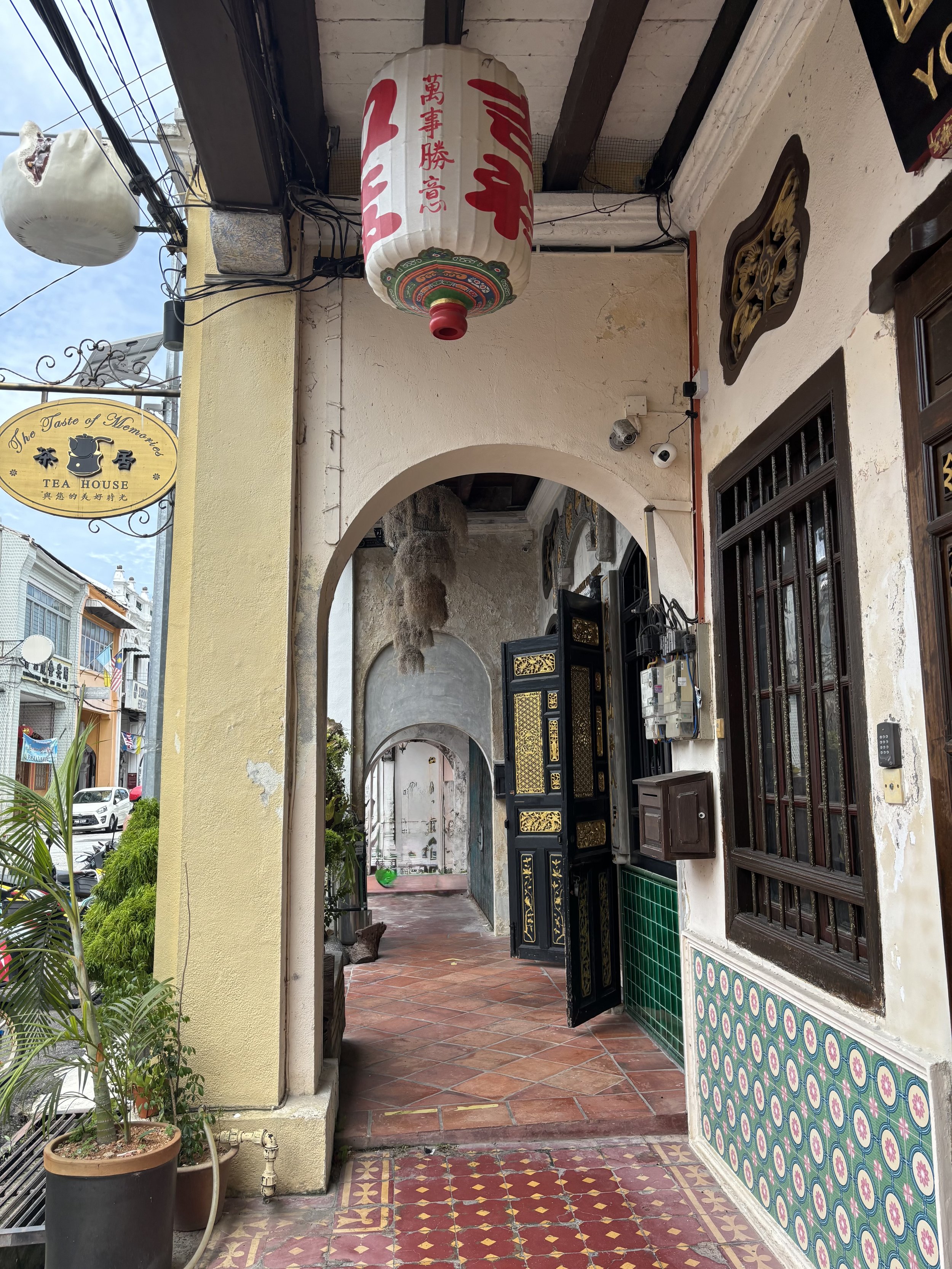
Penang, Malaysia
Where Culture Meets Stories and a Few Laughs
Penang was our first introduction to Malaysia. We chose the city because someone whispered street food capital and we stopped listening to anything else. For me, it was also about durian. Cary was less than thrilled, but I insisted we track down the island’s famous durian stall when we went to Penang.
The place was nothing fancy, plastic chairs, a handwritten sign, and a man wielding a cleaver like it was an extension of his arm. The second he cracked open a durian, the smell rolled across the street like a dare.
Cary muttered through his pinched nose, “I swear something died here.”
“That’s because you don’t know greatness when you smell it, “ I said, already reaching for a piece of durian, “This is very good.”
I bit into the custard texture, It is mildly sweet… cream overload with a cheeky hit of alcohol. Basically, perfection.
Cary eyed me like I am auditioning for Fear Factor. “So? Heaven?”
“Heaven,” I nod.
He shakes his head. “Cheesecake should never smell like wet socks.”
I push the plate toward him. “Try it.”
“Nope. I’ll stick with char kway teow. At least it doesn’t smell like betrayal.”
In Penang, durian is not just fruit. It is a symbol of local pride, and one of the island’s most talked-about food experiences..
For me, durian is a bliss.
Forget the beaches, I’d return to Penang purely for the durian hit.
Why Penang is Perfect for Slow Travel
Penang works for slow travel because it offers more than one rhythm. Mornings in Penang meant kaya toast and kopi at a corner café, the waiter sliding coffee down like we’d stumbled into a diner scene. By noon we were wandering Little India, gold bangles flashing and spices perfuming the air, and later found ourselves in Pulau Tikus, alone in a temple courtyard where even the cat seemed to move in slow motion.
Comfort followed us everywhere, Grab cars arriving before Cary could find his glasses, hotels worshipping at the altar of air-conditioning, and the cable car whisking us up Penang Hill without breaking a sweat. The food alone felt like a world tour: laksa that apologized to arteries, nasi kandar that can be tailored to whatever you’re craving, and cendol so cold it dared you to eat fast. Locals added the final layer, from hawker aunties threatening us like family to strangers pointing us toward their favorite stalls. Cary finally sighed, “This place is my speed.” I grinned, “That is the beauty of Penang. Slow travel here feels just right.”
What Makes Penang Different
Street food concentration: While Malaysia has great food everywhere, Penang is where hawker culture is most celebrated. The density of famous stalls in Georgetown and Gurney Drive makes the island feel like one giant food court.
Compact heritage core: Georgetown’s UNESCO zone is walkable. In other Malaysian cities, you often need a car to hop between cultural sites, but in Penang you can wander on foot and pass temples, murals, shophouses, and mansions within a few blocks.
Street art culture: Street art culture in Penang turned the city’s crumbling walls into a living gallery.
UNESCO status with daily life intact: Georgetown has not become a museum town. Some families still live above shophouses, children ride bikes through mural alleys, and temples are active, not staged. That lived-in quality is rare compared to some more polished heritage zones.
Best Areas to Stay in Penang for Slow Travel
Georgetown
This is Penang’s heartbeat. Food stalls hiss on every corner, murals sneak up on you in alleys, and heritage hotels creak like they are gossiping about the guests. Walk it, eat it, and then walk it again because you will absolutely eat too much. We try a few hotels here, such as Hotel Penaga and the Blue Mansion Hotel. Some charming, some quirky enough that Cary asks if the ghosts charge extra.
Best for: Couples and food lovers who want to be in the middle of it all.
Batu Ferringhi
Penang’s beach escape. Resorts stretch along the sand, the night market springs to life after dark, and you quickly learn that sarongs, coconuts, and questionable massage offers are the island’s version of small talk.
Best for: Travelers who want resort comfort with local flavor nearby.
Tanjung Bungah
Stuck between Georgetown’s chaos and Batu Ferringhi’s neon, this area feels like the pause button. Quieter nights, slower mornings, and fewer tourists trying to photograph their noodles before eating them.
Best for: Couples who want balance between city access and a calm base.
Penang Hill
Take the Penang Hill cable-ride, just 15 minutes from Georgetown. You will find yourself in cool rainforest air with panoramic island views. Rainforest trails, wide views, and Kek Lok Si Temple glowing with lanterns.
Best for: Travelers who enjoy temples, cool evenings, and fewer tourists.
Slow things to Do in Penang
Temples and Mansions
Kek Lok Si Temple
Part theme park, part spiritual marathon, it is a riot of lanterns, staircases, and one giant goddess statue watching you sweat your way uphill.Blue Mansion
Indigo walls so bright they could signal ships, restored to perfection, and just smug enough to remind you that money really can buy style.Pinang Peranakan Mansion
It is part history lesson, part interior design flex, all chandeliers, porcelain, and enough carved teak to make Ikea weepGeorgetown Mansion
A new addition to Georgetown. The mansion promised history, heritage, and maybe a whiff of colonial intrigue.
Street Art Walks
When we went to Penang, we ended up walking in circles, convinced the mural we wanted was just around the corner. Three blocks later, we realized we had looped back to the same café, the same cat stretching in the doorway, the same man who now thinks we are stalking his fruit stall.
Georgetown is generous with its art, but not with directions. Murals appear wherever the artist feels like painting, steel cartoons pop up on random walls, and unless you have a plan, you will sweat through your shirt before you find the famous Boy on a Bike.
That is why I recommend StreetArtPenang.com site map. Unlike the hotel maps that look like they were designed by someone who has never left the lobby, this site actually tracks the murals. It offers two routes: a short 2-kilometer loop for highlights, and a longer 5-kilometer version if you are the type who believes art is better with blisters.
Cary votes for the short route. “We are not here to train for a marathon,” he insists. I argue that art should be earned, not rationed. Five minutes later we are both dripping sweat, bargaining for iced coffee, and agreeing that maybe the shorter walk was the wiser choice.
For slow travelers, the site is a gift. It keeps the fun of discovery but saves you from the dreaded “Penang street art shuffle.” Endless circles, rising humidity, and the sinking feeling that the mural you want is mocking you from the other side of town.
Take the map, go early morning or late afternoon, and build snack breaks into your route. The art is free. The coffee and cold towels are not, but trust me, they are part of the experience.
Nature and Beaches
Penang Hill
Ride the funicular and trade sweat for cool air, rainforest trails, and views that make you forget the climb.Penang National Park
Hike or boat your way to Monkey Beach and Turtle Beach, where the wildlife has better beachfront property than most resorts.Batu Ferringhi
Sand in the day, neon at night — the beach hands over to the night market without missing a beat.
Neighborhood Hidden Gems
Pulau Tikus
The name came from a little islet shaped like a rat at low tide. Luckily, the neighborhood itself is far less rodent-y. It sits just outside George Town, close enough for convenience but far enough that your eardrums get a break. Think of George Town on a double espresso, then imagine it after a nap and a steaming bowl of noodles. That’s Pulau Tikus. Quiet streets, solid food, and the kind of understated charm that makes you question why the guidebooks keep sending you back into the circus. It is also a cultural mash-up in the best way—Eurasian, Burmese, and Thai communities call it home.
Little India & Chulia Street
Absolute chaos in the best possible way. The smells alone could knock you flat, and every food stall looks like it is daring you to risk both your arteries and your dignity. If you leave hungry, that is on you.Hin Bus Depot
Once a bus yard, now a hipster paradise. Art installations, music, cafés, and the smug thrill of telling people back home you “found this amazing place that no one knows about.” Spoiler alert - everyone knows about it. But hey, the coffee is good and the people-watching is excellent.
Best Time to Visit Penang
Penang never really gets cold. It is tropical, which means warm, humid, and sometimes wet. The good news: food tastes just as good whether the sun is shining or the rain is pounding like a bad drum solo. The better news, you can pick your season depending on whether you want sunshine, bargains, or room to breathe.
Seasons
Dry Season (November to March)
Skies clear, rain takes a holiday, and a breeze occasionally drifts through Georgetown like a gift. This is when Penang is at its easiest. Everyone else knows it too, which means more people and pricier hotels. Still, you can stroll through temples and markets without melting into the pavement, which feels like a small miracle. The dry season roughly falls between November and March, with less rainfall and more favorable conditions for outdoor activities.
Shoulder Seasons (March - May and from September– November)
This is where slow travel shines. A little sun, a little rain, and enough space to actually hear yourself think. During these months, the weather is still pleasant with relatively good beach conditions and lower tourist crowds compared to the peak dry season of December to February. This makes shoulder seasons a good time to visit for travelers seeking a balance between decent weather, fewer crowds, and more affordable prices.
Rainy Season (April - November)
Rain does not sneak in, it crashes the party. Heavy, fast, and usually done before you finish lunch. Cary calls it “nature’s way of scheduling nap time,” which fits our pace perfectly. Museums, hawker stalls, and coffee shops carry on as if nothing happened, so do we. Slow travelers are built for this — all it means is more time to linger.
Crowds and Festivals
December to February is busy thanks to Christmas, New Year, and Chinese New Year. Hotels charge more and traffic feels like a group therapy exercise.
School holidays in Malaysia (March, May-June, July-August, and December) bring more local families. Expect busier mornings at markets and livelier beaches.
Festival season is glorious but crowded.
Chinese New Year (Jan/Feb)
The island bursts with lanterns, fireworks, and lion dances. It is spectacular, but traffic crawls and hotels cash in. Worth it if you love pageantry, less so if you hate queues.George Town Festival (July/August)
The whole city becomes a stage with art, music, and performances tucked into alleys and courtyards. Fantastic for culture lovers, but Cary calls it “an endurance test for people who do not like sitting still.”School Holidays (mid-June, August, December)
Hotels fill, attractions buzz, and beaches suddenly resemble group therapy sessions. If you want peace, dodge these weeks. If you enjoy people-watching, it is the Olympics for families on vacation. Check here to find out the Malaysia public holidays.
Timing Your Trip
The best time to hit Penang was the dry season, from November to March, when the skies behaved and the air didn’t feel like soup. The weather is perfect for wandering, sweating just enough, and grabbing a beach beer before sunset. The only catch? Everyone else had the same idea, so prices climbed and crowds packed in, especially through December and January.
Getting Around
Driving yourself in Penang? Hard pass. Traffic snarls, parking is a scavenger hunt, and the roads are best left to locals who treat scooters like chess pieces. We stick to two options: ride-hailing apps and a personal driver.
Grab and AirAsia Ride work perfectly for short hops, hotel to hawker stalls, Georgetown to Batu Ferringhi. No haggling, no “special tourist price,” just tap and ride.
For a longer day, a personal driver is worth every ringgit. For around RM 500 (about 80 - 110 USD) you get a private car and driver for 8 hours, enough to cover Georgetown, Kek Lok Si Temple, Penang Hill, and still stop for char kway teow without watching the clock. It is not just transport, drivers double as guides, storytellers, and traffic whisperers. Cary swears it is the best money we spend because instead of him navigating, he gets to nap and complain about the traffic in peace.
Slow travel thrives on this. You move at your own pace, stop when something catches your eye, and end the day without feeling like you survived a rally race.
Where to Find a Personal Driver in Penang
Hotel front desk
Most hotels in Penang have drivers they call regularly. Prices may be a little higher, but you get reliability, plus someone the hotel trusts.Local tour operators
Sites like Klook let you pre-book private drivers with set rates (about RM 360 for 8 hours in a sedan).Word of mouth
Ask locals, especially café owners or hawker stall vendors. Penang is small enough that good drivers get recommended quickly.Ride-hailing apps (Grab / AirAsia Ride)
These are best for short trips, but some drivers will agree to a full-day rate if you message them directly through the app. It never hurts to ask.
Pro tips
Spice levels are not a suggestion
When locals say “a little spicy,” they mean “pack tissues.” Start mild, then negotiate with sambal on the side.Cash is still king
ATMs are everywhere, but small hawker stalls and markets often will not break large notes. Keep a stash of RM 1 and RM 5 bills or be ready to buy everyone behind you a round of noodles.Internet in Penang
Getting online in Penang is no headache. We bought a local SIM card right at the airport, cheap and cheerful, and it worked fine. Hotels throw in WiFi, and cafes almost always have it too. But if you are hopping from country to country, yanking out tiny bits of plastic starts to feel like a side hobby you never signed up for. That is where the eSIM quietly wins.Download Grab app and thank yourself later. It is the Swiss Army knife of Southeast Asia rides when you are melting in the heat, and food when leaving the hotel feels like a survival sport. Hook up your credit card in the app and you are done. No fumbling with cash, no math panic at the thought of exchange rates. Just tap, wait, and let someone else deal with traffic while you work on your iced coffee strategy.
Set up your eSIM before flying to Penang. pour yourself a coffee, and land already connected. Less headache. Sip your coffee, board your flight, and land already connected—no kiosk hunt, no headache.
Penang can play the greatest hits, George Town murals, street food, and beaches. But the real magic hides in the quiet streets, late-night snacks, and odd little corners locals point you toward with a grin. Skip the tourist choreography, follow your curiosity, and you will leave with better stories than any brochure could sell. Penang rewards slow travel, you need to take it slowly to truly enjoy it.
Ready to plan your own trip? Start by sorting out your e-SIM, your Grab app, and your appetite. The rest of Penang will happily handle itself.
More Travel Stories
This was our Penang hub. Every time we added a new story, it lived here. Think of it as the coat rack where all our Penang tales hung, so no one had to dig around wondering,
Keep scrolling to see our latest














